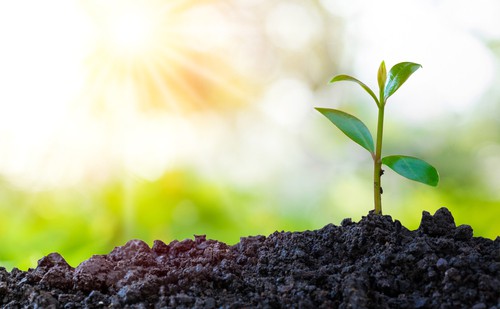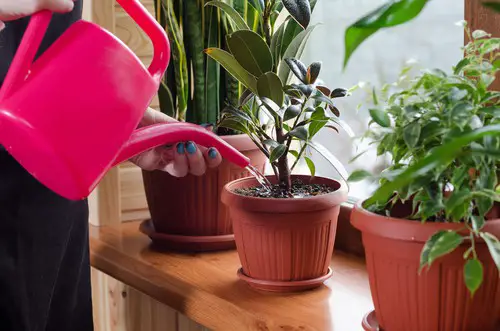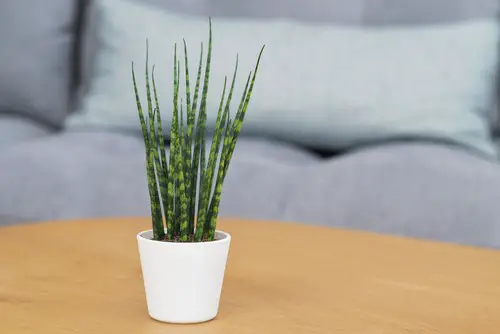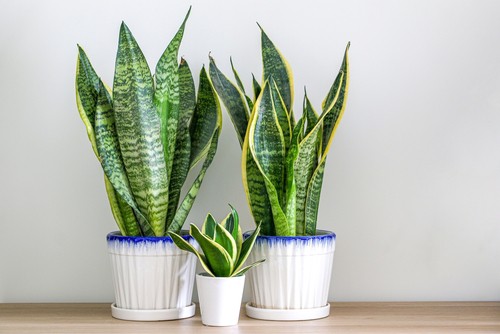Snake plants are a popular indoor plant choice due to their low maintenance and air-purifying qualities. However, if you notice the tips of snake plant turning brown, it can be concerning.
Brown tips on snake plants are a common issue that many indoor gardeners face. In this article, we will explore the causes, symptoms, and treatment methods for snake plant brown tips.
Understanding snake plant health is essential to keep them thriving. Snake plants are hardy and can tolerate a range of conditions, but they do have specific care requirements.
Brown tips on snake plants are a sign that something is not right, and it is crucial to identify the cause to prevent further damage. Inconsistent watering, low humidity, and over-fertilization are some of the common causes of brown tips on snake plants.
Key Takeaways
- Brown tips on snake plants are a common issue that indoor gardeners face.
- Understanding snake plant health is essential to keep them thriving.
- Inconsistent watering, low humidity, and over-fertilization are some of the common causes of brown tips on snake plants.
More on this category:
Understanding Snake Plant Health

Snake plants, also known as Sansevieria, are popular houseplants known for their easy maintenance and air-purifying qualities. However, if you notice the tips of your snake plant turning brown, it may indicate a problem with its health.
Here are some factors that can affect the health of your snake plant:
- Watering: Overwatering or underwatering can cause the tips of the leaves to turn brown. Snake plants prefer to be watered only when the soil has completely dried out.
- Light: Snake plants can tolerate low light, but too much direct sunlight can cause the leaves to burn and turn brown.
- Humidity: Snake plants prefer low to moderate humidity levels. High humidity can cause fungal diseases, while low humidity can cause the tips of the leaves to turn brown.
- Temperature: Snake plants prefer temperatures between 60-85°F (15-29°C). Extreme temperatures can cause the leaves to turn brown.
- Fertilizer: Overfertilization can cause the tips of the leaves to turn brown. Snake plants only need to be fertilized once or twice a year.
- Pests: Spider mites and mealybugs are common pests that can cause the tips of the leaves to turn brown.
To keep your snake plant healthy, make sure to provide it with the proper care. Water it only when the soil has completely dried out, place it in a well-lit area away from direct sunlight, and maintain moderate humidity levels. If you suspect a pest infestation, treat it promptly with insecticidal soap or neem oil.
By understanding the factors that affect the health of your snake plant, you can ensure that it stays healthy and vibrant for years to come.
Causes for Brown Tips
Snake plants are easy-to-care-for houseplants that can thrive in a variety of conditions. However, even the most low-maintenance plants can experience issues, and one common problem with snake plants is brown tips. Here are some of the most common causes for brown tips on snake plants:
1. Inadequate Watering
One of the most common causes of brown tips on snake plants is inadequate watering. Snake plants prefer to be watered only when their potting soil has completely dried out.
If they are overwatered or underwatered, their health can suffer, and the look of the plant will deteriorate. Underwatering can cause the plant’s xylem tissue to be unable to transport nutrients and food to the tips of the leaves, causing them to dry out and turn brown. Overwatering can cause root rot, which can also lead to brown tips.
2. Excessive Sunlight

Another common cause of brown tips on snake plants is excessive sunlight. While snake plants do well in bright, indirect light, too much direct sunlight can scorch their leaves, causing them to turn brown.
If a snake plant is placed in a window with direct sunlight, it may be necessary to move it to a spot where it can receive slightly less direct sun.
3. Incorrect Temperature
Snake plants are tolerant of a wide range of temperatures, but extreme fluctuations in temperature can cause stress to the plant, leading to brown tips. Keep snake plants away from drafty areas or hot spots, such as near radiators or air conditioning units.
Ideally, snake plants should be kept in a room with a temperature between 60 and 85 degrees Fahrenheit.
4. Poor Nutrition
Finally, poor nutrition can also cause brown tips on snake plants. Snake plants are not heavy feeders and can survive in low-nutrient soil, but they still require some basic nutrients to stay healthy.
If a snake plant is not getting enough nutrients, its leaves may start to turn brown. Consider fertilizing the plant with a balanced, water-soluble fertilizer every two to three months during the growing season.
By addressing these common causes of brown tips, snake plant owners can keep their plants healthy and looking their best.
Identifying Symptoms
Snake plants are known for their hardiness and resilience, but they are not immune to problems. One of the most common issues that snake plant owners face is brown tips on the leaves. This section will discuss the symptoms of a snake plant with brown tips.
The first symptom is, of course, brown tips on the leaves. The tips may be completely brown or have a brown edge. In some cases, the brown may be accompanied by yellowing or wilting of the leaves. This can happen to any of the leaves on the plant, but it is most common on the older leaves.
Another symptom to look out for is a general decline in the health of the plant. A snake plant with brown tips may start to look droopy or wilted. The leaves may lose their stiffness and start to bend or curl. The overall color of the plant may also start to look dull or faded.
If you notice any of these symptoms, it is important to take action quickly. Brown tips on a snake plant are often a sign that something is wrong, and if left untreated, the problem can quickly escalate. In the next section, we will discuss the common causes of brown tips on a snake plant.
Preventive Measures

1. Proper Watering
Snake plants are drought-tolerant and prefer dry soil. Overwatering can cause root rot, which can lead to brown tips. Therefore, it is important to water the plant only when the top inch of soil is dry.
During the winter, when the plant is dormant, it requires even less water. It is also essential to ensure that the pot has proper drainage to prevent water from pooling at the bottom.
2. Adequate Sunlight
Snake plants prefer bright, indirect sunlight. Direct sunlight can cause the leaves to burn, leading to brown tips. If the plant is not getting enough light, it may become weak and more susceptible to diseases and pests. Therefore, it is important to place the plant in a location where it can receive adequate sunlight.
3. Ideal Temperature
Snake plants prefer temperatures between 60 to 85 degrees Fahrenheit. Temperatures below 50 degrees Fahrenheit can cause the leaves to turn brown. Therefore, it is important to keep the plant away from cold drafts and air conditioning vents.
4. Right Nutrition
Snake plants do not require frequent fertilization. Over-fertilization can cause salt buildup in the soil, which can lead to brown tips. Therefore, it is important to fertilize the plant only once or twice a year with a balanced fertilizer.
It is also essential to avoid using fertilizers that contain too much nitrogen, which can cause the leaves to become soft and weak.
By following these preventive measures, one can keep their snake plant healthy and prevent brown tips.
Treatment Methods

Snake plants are resilient and can recover from brown tips with the right treatment. Here are some effective methods to treat brown tips on snake plants.
1. Trimming Brown Tips
If the brown tips on the snake plant are minor, trimming them off can help improve the plant’s appearance. Use a sharp, sterile pair of scissors or pruning shears to trim the tips. Be sure to cut at an angle to prevent water from pooling on the cut surface, which can lead to fungal growth.
2. Adjusting Watering Schedule
Over-watering is a common cause of brown tips on snake plants. To prevent this, adjust the watering schedule. Snake plants should be watered only when the soil is dry to the touch. Check the soil moisture level by sticking a finger about an inch deep into the soil. If it feels dry, it’s time to water the plant.
3. Modifying Light Exposure
Snake plants thrive in bright, indirect light. If the plant is getting too much direct sunlight, it can cause brown tips. Move the plant to a location with less direct sunlight, or use a sheer curtain to filter the light.
4. Changing Temperature Conditions
Snake plants prefer temperatures between 60°F and 85°F. If the plant is exposed to temperatures outside of this range, it can cause stress and lead to brown tips. Move the plant to a more suitable location or adjust the temperature in the room.
5. Improving Nutrition
Snake plants are low-maintenance plants that don’t require much fertilizer. However, if the plant is not getting enough nutrients, it can cause brown tips. Use a balanced fertilizer once a month during the growing season to improve the plant’s overall health.
By following these treatment methods, snake plant owners can effectively treat brown tips and help their plants thrive.
Conclusion

Snake plants are generally easy to care for and maintain, but their tips can turn brown for a variety of reasons. The most common cause of brown tips is underwatering, followed by low humidity, cold sensitivity, improper watering patterns, slow growth, pest invasion, poor drainage, and excess fertilization.
To prevent brown tips, it is important to water the snake plant only when the soil is completely dry and to maintain a consistent watering schedule. Additionally, snake plants prefer moderate to high humidity levels, so it is important to keep them in a room with sufficient moisture or to use a humidifier.
If the snake plant is placed in a spot with too much direct sunlight, it can lead to brown tips. Moving the plant to a spot with less direct sunlight can help alleviate this issue. If the plant is infested with pests, it is important to use a natural insecticide to eliminate them.
Frequently Asked Questions
How to fix brown tips on snake plant?
Brown tips on a snake plant are usually a sign of overwatering or underwatering. To fix brown tips on a snake plant, it is important to adjust the watering schedule.
Snake plants only like to be watered once their potting soil has completely dried out. It is also important to ensure that the plant is not placed in direct sunlight, which can cause sunburn and brown tips.
Snake plant leaves turning brown and crispy?
If the entire leaf of a snake plant is turning brown and crispy, it may be a sign of underwatering. Snake plants prefer to be watered when the soil has completely dried out.
Additionally, low humidity levels can cause stress to the plant, resulting in brown and crispy leaves. Increasing the humidity around the plant can help prevent this issue.
Snake plant turning brown at base?
If the base of a snake plant is turning brown, it may be a sign of root rot. This can occur when the plant is overwatered or the soil is not well-draining.
To fix root rot, it is important to allow the soil to dry out completely before watering the plant again. It may also be necessary to repot the plant in fresh, well-draining soil.
Why is my snake plant turning brown in the middle?
If the middle of a snake plant is turning brown, it may be a sign of overwatering or underwatering. It is important to adjust the watering schedule and ensure that the plant is not placed in direct sunlight.
Why are the tips of my spider plant turning brown?
Spider plants can also develop brown tips due to underwatering or overwatering. It is important to adjust the watering schedule and ensure that the plant is not placed in direct sunlight. Additionally, spider plants prefer to be kept in a humid environment.
How often to water snake plant?
Snake plants only need to be watered once the potting soil has completely dried out. This can vary depending on the temperature and humidity levels in the environment. It is important to avoid overwatering, as this can lead to root rot and brown tips.

Hey, I’m Lisa and I’ve been an avid gardener for over 30 years. I love writing, talking and living in the garden! Feel free to connect with me on my socials below

